Share

Paraplanners' Assembly
Why is it all kicking off in the world of retirement income planning?
Season 1, Ep. 9
•
Years of stability in the retirement income planning world changed abruptly on 23 September 2022 when former Chancellor of the Exchequer, Kwasi Kwarteng, presented his ‘mini budget’.
Ever since, uncertainty about rising interest rates, anxieties about inflation, and even worries over the stability of pension funds themselves, have led paraplanners to rethink how clients can achieve the outcome they want from their financial plan.
One consequence of all this? Secure lifetime income has become a thing. And annuities are back in fashion.
In the first of a three-part series, Richard was joined by Karl Steadman from Just to explore what’s changed in the world of retirement income planning and what it means to paraplanners.
More episodes
View all episodes
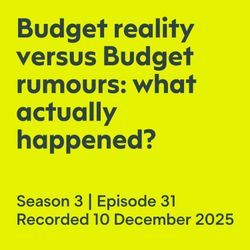
31. Budget reality versus Budget rumours: what actually happened?
01:00:09||Season 3, Ep. 31Budget measures are often the subject of media speculation. But the level of attention in the run-up to the Chancellor of the Exchequer’s Budget statement on 26 November 2025 was unprecedented.So did the reality match the hype? For our final Assembly of 2025, we invited Les Cameron from M&G Wealth to join us and share his latest thoughts on what paraplanners need to know following Rachel Reeves’s statement.Les covers a bunch of different topics that include:Inheritance tax changes and business relief updatesCapital gains tax rates and allowancesISA allowancesPensions, IHT liability and the role of personal representativesSalary sacrificeTax rates, bands and allowancesBeneficial orderingThe effect of fiscal drag (or ‘stealth taxes’)Plus more besides. So if you want to catch up with what's been announced, what's changing, or what's staying the same, this is the Assembly for you.Assemblies featuring the M&G technical team in 2025This is the fifth Assembly of the year featuring experts from M&G Wealth's technical team. Here are the other four from 2025:February 2025 – Pensions, death and taxes (with Les)April 2025 – A guide to investment bond essentials for paraplanners (with Barrie Dawson)August 2025 – Tax wrappers: which, why and when? (with Neil Macleod)September 2025 – The pension IHT bombshell has landed – now what? (with Les)Useful linksCPD: Request your certificateDownload: Les's slidesWatch the replay at Crowdcast (with chat)Listen to the podcast episode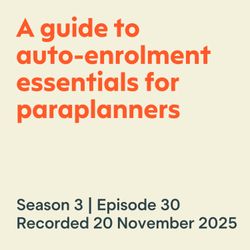
30. A guide to auto-enrolment essentials for paraplanners
23:13||Season 3, Ep. 30It’s been more than a decade since auto-enrolment in workplace pensions was first introduced by the UK Government.And it’s fair to say that the measure has transformed the level of pension saving in the workplace. Plus it’s transformed the role that businesses (and their owners) can play in the financial wellbeing of their employees.Mind you, there are plenty of paraplanners who weren’t around when auto-enrolment was rolled out. Or when the Pensions Commission was formed in 2005. Or when personal pensions were launched in 1988. So in this bonus Assembly episode, we asked Barnett Waddingham’s DC pension and employee benefits expert, Lucy Clark, to provide paraplanners - whatever your level of expertise - with a primer on the origins of workplace pensions, auto-enrolment and where things might be going in the future. In just 20 minutes, Lucy provides a potted history of personal pensions, stakeholder pensions, why the original Pensions Commission was formed and its legacy.What’s more, Lucy walks through the employer duties that need to happen each pay period and the common pitfalls she sees in practice (contribution deductions and certification crop up a lot). She offers a helpful explanation of the net pay anomaly that's affected lower earners in occupational schemes and – this is a new one for us – Lucy talks about 'sidecar savings': an idea that could help people build emergency funds alongside their pension in future.Speaking of the future, Lucy also considers what it might hold. We're talking potential changes to age thresholds, removing the lower earnings limit, and the ongoing push for contribution adequacy.This is a fantastic backgrounder packed with knowledge, know-how and insight from a DC pension and employee benefits expert. Useful linksHere are the slides that Lucy ran through during her conversation with Richard.Download: Lucy's slides Listen to the podcast episode
29. What can the professional bodies do for you?
01:00:36||Season 3, Ep. 29As paraplanners, many of us hold memberships with Chartered Institute for Securities and Investment (CISI), Personal Finance Society (PFS), or pay for LIBF courses.So we pay our fees, collect our CPD, and maybe sit an exam or two. But are we really getting the most from these organisations? What do they offer that can support us in our careers? And is one more suited to me than another? Or are all three much the same?That’s what this Assembly was all about. We invited Chris Morris from CISI, Nicola Mellor from the PFS, and Sally Plant from LIBF to field questions posed in advance and in the chat by paraplanners.Note: Because technology didn’t work the way it’s supposed to, Sally wasn’t able to join us on screen BUT she did join us in the Chat while her colleague (and director of financial services at the LIBF) John Somerville, was able to join Richard, Chris and Nicola on screen (from about 15 minutes in).It’s a great conversation from start to finish and comprehensively explored:What specific support does each body offer paraplanners – and what makes the difference between themHow can paraplanners influence the work of the organisations and how to get involvedWhether there’s a place for paraplanner-specific qualificationsHow does membership work, what are the costs involved, and why do you need to maintain a membership (for PFS and CISI)Plus plenty more.What can you expect to take away?Once you’ve listened or watched, you’ll have a much clearer understanding of what each professional body offers, which could be the right one for you, and how you can get more value from your membership.Look out for another installment in 2026There was so much to talk about that we didn’t manage to address even 50% of the questions that paraplanners had submitted so we’ll be setting up a second session featuring Chris, Nicola and - hopefully - Sally early in 2026.Useful linksWatch the Replay at Crowdcast (with Chat)CPD: Request your certificateCISI’s websitePFS’s websiteLIBF’s website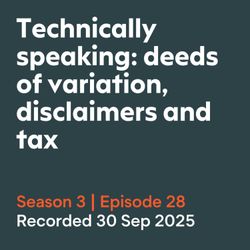
28. Technically speaking: deeds of variation, disclaimers and tax
01:01:01||Season 3, Ep. 28When a client dies, their will isn’t necessarily the final word on how their estate gets distributed. Deeds of variation and disclaimers give beneficiaries a valuable window – two years from death – to reshape inheritances in ways that can reduce tax bills and improve family outcomes – often both.In the latest episode in our ‘Technically speaking’ series, we invited Steve Sayer from Utmost to join host Richard Allum, to cast his expert gaze on the post-death planning issues that paraplanners need to consider.During the hour-long session, Steve explains:how deeds of variation work;the conditions needed for them to be effective for IHT and CGT purposes;practical situations where they make sense;related settlements;‘reading back’ provisions; andCGT planning opportunities that variations can create.What’s more, the session also explores disclaimers – the simpler but more restrictive alternative to variations. Steve clarifies:the ‘all or nothing’ rule;when disclaimers work best; andhow they differ from deeds of variation in practice.Throughout the episode, Steve offers examples to help illustrate concepts such as periodic charges and ten-year anniversaries.If you’re working on suitability reports that cover post-death planning options, are supporting a client following a death, or would just like to give your technical knowledge a boost, this is the ideal ‘Technically speaking’ episode for you.Useful linksCPD: Take the quiz to receive your certificateSlides: Deeds of variation and disclaimersPodcast: Listen on AcastUtmost Technical Academy webinar seriesUtmost x Paraplanners' Assembly: all our previous sessions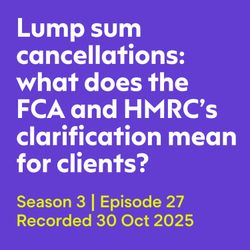
27. Lump sum cancellations: what does the FCA and HMRC's clarification mean for clients?
22:00||Season 3, Ep. 27It's more than a year since speculation ahead of last autumn's Budget led to a surge of savers raiding their pension pots in a bid to beat rumoured changes to tax-free lump sums. But when no changes were announced and people sought to reverse their withdrawals, they discovered that the 30-day cancellation rule didn't apply. Or did it?That confusion over conduct of business rules led to calls for HMRC and the FCA to clarify whether or not savers could cancel – and they've now responded.In this episode of the Paraplanners' Assembly podcast popular Assembly expert, James Jones-Tinsley of Barnett Waddingham explains how cancellations became an issue, what the clarification means for clients, what regulatory issues the statement throws up, and what paraplanners need to know from now on.Useful linksDuring the podcast, Richard mentions James's article for FT Adviser, which you can find here:Lump sum cancellations: members have been left vulnerable to misunderstanding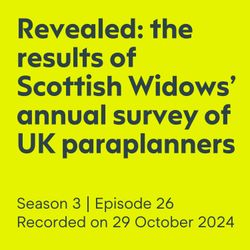
26. Revealed: the results of Scottish Widows’ annual survey of UK paraplanners
01:01:31||Season 3, Ep. 26If you want to know what's on the minds of other paraplanners, then this is definitely the Assembly for you.That’s because Scottish Widows's Craig Spittal joined host, Richard Allum, and guest Alison Neale of Principle Paraplanning, to exclusively reveal key findings of this year's Scottish Widows' Paraplanner Survey ahead of it's formal publication in November 2025.Original insights on the big issuesDuring this recording of a lunch-hour online Assembly, Craig shares findings from a sample of 200 paraplanners who completed the third annual survey of paraplanners. Topics covered include:Job satisfaction – Do your paraplanning peers feel supported in their current role? And how eager are they to gain greater recognition and influence, and clarity over possible career paths? How high is confidence in the profession overall – and is it the same for everyone at every age?Platforms and due diligence – How many platforms do paraplanners use day to day? And what are the issues that grind paraplanners gears? Tune in to hear Alison, Craig and Richard’s thoughts.AI and tech – Is the desire for automation matched by tech adoption in paraplanners firms? Or are things moving far slower than the hype suggests? What - if anything - is holding paraplanners back from AI adoption? And how convinced is the community by the promise of AI? Does the carrot of greater efficiency dilute concerns about accuracy and data security?What can you expect to take away?Listen and you’ll hear practical insights, honest reflections, and a clear idea of where paraplanners like you think our profession is heading.So tuck in to a helping of hot-of-the-press original research and take this chance to reflect on the attitudes and trends that are influencing paraplanning today.Useful linksMake sure to grab your CPD certificate for watching or listening to this Assembly by visiting the link below. You can also download the slides that Craig shared during this Assembly.CPD: Request your certificateScottish Widows Paraplanner Survey Report 2025Download: Craig's slides (opens PDF in new tab)Watch the Replay at Crowdcast (with Chat)Listen to the podcast episode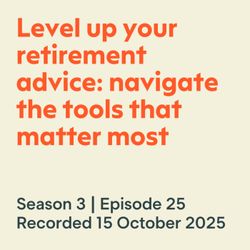
25. Level up your retirement advice: navigate the tools that matter most
57:48||Season 3, Ep. 25As paraplanners, we have the power to transform retirement outcomes by understanding how product innovations can take these critical risks off the table. But are we truly using the full toolkit available to us? Or are we sticking with conventional approaches that might not deliver the stable, reliable income our clients need?It matters because retirement planning has evolved beyond traditional drawdown strategies. The FCA expects us to distinguish between accumulation and decumulation approaches, and innovative product solutions now exist that can protect clients from running out of money.Expand your knowledge in one hourThis Assembly was the second part of our exploration into the retirement risk zone, focusing specifically on how product innovations can deliver better outcomes for your clients and featuring guest Connor Stewart from Standard Life in conversation with host Richard Allum.Together, they explore what clients want from retirement, how regulatory expectations are driving change, and how you can use cutting-edge product solutions to deliver the security and growth your clients need.What can you expect to take away?This episode offers actionable insights into product innovations that can transform your retirement planning approach. You’ll understand how to match these solutions to specific client needs and circumstances, ensuring you can deliver genuinely tailored retirement strategies.Useful linksHere are useful links and downloads from this event. Standard Life have created a dedicated page for this event where you can access your CPD. Just follow the link.CPD: Download your certificateWatch the Replay of this Assembly at Crowdcast (with Chat)Video: watch this Assembly at Vimeo (does not include Chat)Download: Connor's slidesWeb: Event page at paraplannersassembly.co.ukPart one in this seriesWeb: Part one at paraplannersassembly.co.ukWatch the Replay of part one at Crowdcast (with Chat)Video: watch part one at Vimeo (does not include Chat)Podcast: listen to part one
24. Looking forward to The Big Day Out 2025
20:23||Season 3, Ep. 24In this bonus episode, The Big Day Out 2025 hosts, Aleks Sasin and Chris Wormell, join one of the Paraplanners' Assembly organisers, Maxine Cameron, to look forward to our annual gathering at FarmED near Chipping Norton in the Cotswolds.In 20 minutes you'll learn all about:the practical AI session with Harriet Mayer that's focused on hands-on writing tools that work for all experience levels, from complete beginners to regular AI users.the technical sessions which allows participants to pick-and-mix between essential and advanced level scenarios for IHT and retirement income planning, allowing you to tailor your learning to your current skill level.Zara Okoro's career development session that will helps you identify next steps for your professional growth, regardless of whether you're in-house, outsourced, or still figuring out your path.why connections at The Big Day Out —even small ones—can create lasting professional relationships – and the informal, friendly atmosphere makes it easier to join conversations even if you're naturally introverted.just how The Big Day Out is designed by paraplanners for paraplanners, creating an inclusive environment where nobody is trying to sell you anything and experts from our supporters participate as equalsThere are a handful of tickets left if you'd like to take part in this year's annual gathering. To grab a ticket, visit The Big Day Out 2025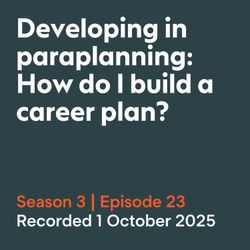
23. Developing as a paraplanner: 'How do I build a career plan?'
01:00:12||Season 3, Ep. 23Whether you’re just starting out in paraplanning or looking to make your next move, having a clear career plan makes all the difference. But how do you actually build one that works?That’s what this Assembly is all about: the practicalities of creating a plan for your career; an approach that you can use no matter what stage you’re at in your professional life.Your career roadmap in just one lunch hourCaroline Stuart, owner and founder of Sparrow Paraplanning, hosted the conversation which featured four brilliant guests: Ellie Welling paraplanning team leader at Succession Wealth, Joe Jacob, paraplanner at FLP, Peter Spence, advice and paraplanning team leader at Fintuity, and Sarah Purves, learning and development expert at Aegon.Together, they explored a practical framework for career planning that goes beyond wishful thinking to create actionable next steps.What can you expect when you watch and listen?During this Assembly we:Explored your career aspirations and help you define what type of role you actually wantIdentified the constraints and opportunities that will shape your path (including your non-negotiables)Considered objectives to move you forwardProvided a template to help you build out your personal career action planLearned from our guests’ experience of starting out and developing as paraplannersWhat you will take awayYou’ll leave with a practical framework that you can use immediately to plan your next career step – plus real-world insights from paraplanners who’ve successfully navigated their own career transitions at different stages.Most importantly, you’ll have a clear action plan rather than just good intentions. So if you’ve been thinking about where you go next in your paraplanning career, this session is the perfect place to turn those ideas into practical actions.A big ‘thank you’ to AegonThis Assembly would not be possible without the generous support of Aegon. Thank you to the team at Aegon for supporting and for backing the development of paraplanners and paraplanning in the UK through their support of the Paraplanners’ Assembly.Useful linksHere are the links mentioned in this Assembly. Once you’ve watched or listened, make sure you tap the link to receive your CPD certificate (first link below).Request your CPD certificateDownload: Sarah's slidesDownload: Career plan templateWatch the replay at CrowdcastEpisode 1 in this careers seriesEpisode 2 in this careers seriesEpisode 3 in this careers series